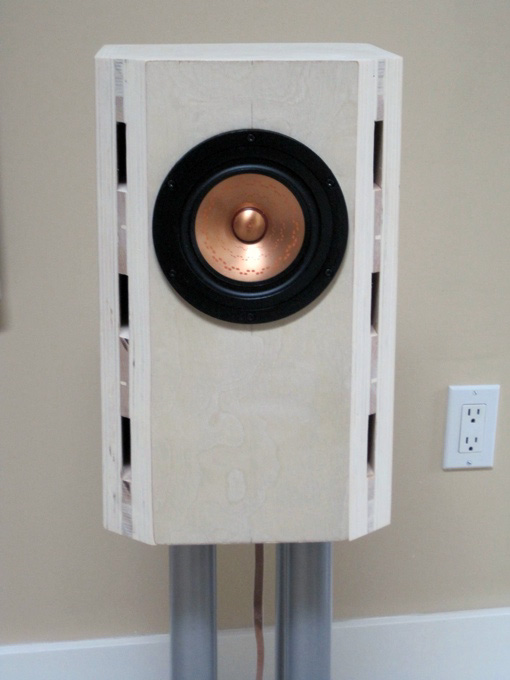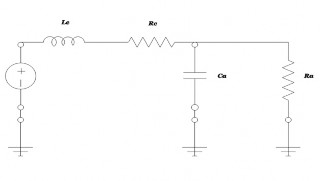Of Carroll Shelby, phono cartridge loading, and my budget reference system…
Firstly, regarding Carroll Shelby: For those that may not know, Mr. Shelby passed away on May 10 (a day I will always remember as it is my birthday). Rather than try to sum up his life in a single page (which would be impossible to do), I just thought that I would draw attention to this fact and to my own limited exposure to his company and foundation.
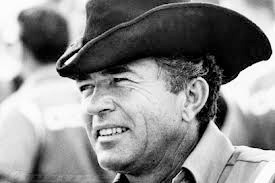 The only personal link I had with Mr Shelby or his organization was through Mark Logan of Shelby Cobras Northwest (and Nevada Classics) and John Luft (president of Shelby American). At the time, my initial contact had been with Shelby American regarding a friend who was looking at various “kit cars”. I tried to suggest that a Cobra from Shelby’s continuation series would be an investment (not trying to “slag” the makers of kit cars, but the Shelby would have a genuine Shelby serial number and would be eligible for inclusion in the Shelby cars registry) that he could enjoy driving and that would retain value as a genuine Shelby. My email was promptly followed up by a phone call from Mr. John Luft, who advanced my name and number to Mark Logan (who promptly called later the same day). My friend chose a kit type car, but in hindsight I believe he has rethought the whole thing and realized that despite the cost disparity he would have been better off taking my advice. The kit-car sits incomplete 2 years on and is a source of frustration for my friend. At a later date I had an occasion to call Mark as a different well-healed friend asked me to help him locate a rare muscle car (a Superbird).
The only personal link I had with Mr Shelby or his organization was through Mark Logan of Shelby Cobras Northwest (and Nevada Classics) and John Luft (president of Shelby American). At the time, my initial contact had been with Shelby American regarding a friend who was looking at various “kit cars”. I tried to suggest that a Cobra from Shelby’s continuation series would be an investment (not trying to “slag” the makers of kit cars, but the Shelby would have a genuine Shelby serial number and would be eligible for inclusion in the Shelby cars registry) that he could enjoy driving and that would retain value as a genuine Shelby. My email was promptly followed up by a phone call from Mr. John Luft, who advanced my name and number to Mark Logan (who promptly called later the same day). My friend chose a kit type car, but in hindsight I believe he has rethought the whole thing and realized that despite the cost disparity he would have been better off taking my advice. The kit-car sits incomplete 2 years on and is a source of frustration for my friend. At a later date I had an occasion to call Mark as a different well-healed friend asked me to help him locate a rare muscle car (a Superbird).
Mark helped out as much as he could given the very strict demands of the search. Unfortunately, (again) this friend ended up not purchasing the car that was located, but has since bought a rarer-yet version of the ‘bird. Both men showed me and my friends nothing but professionalism and the utmost in customer relations. This no doubt was led “from the top” and for this I think I can make a generalized statement regarding Mr. Shelby and his commitment to his cars, his name and his values. His model of customer service could well be adopted by any company wanting to genuinely service their customers (or potential customers) in a non-condescending, true-to-their word manner.
Mr. Shelby was (in my humble estimation) what most automotive heroes should be: an upright, outstanding member of the automotive community, a true automotive and hot rodding innovator and a member of the world community beyond his enterprise fields of endeavour. Simply one of the automotive icons. Successful in both racing (personally) and in business with Shelby International, Ford, and Chrysler (for a few years). I suggest that if people would like to know something about this man, his cars and his life seek out a good book. I have but one book about him which was from Petersen Publishing which was published close to 26 years ago as a “specialty publication”(John Christy and Dave Friedman, Carroll Shelby’s Racing Cobra: A Retrospective Look at the Real Facts Behind the Cobra Legend, Petersen, 1986, First Edition. soft cover. First printing. 218 pp. magazine format. Now worth some money as this version is quite rare, but it will never be for sale). At a time where everything happens in the automotive world for a reason, the likelihood of single individuals having the kind of impact on the performance world as Mr. Shelby did is essentially zero. As a member of the world community, Mr. Shelby established the Carroll Shelby Foundation which has helped provide financial support to countless children suffering from life-threatening illnesses and organizations that provide medical assistance, scholarships in automotive education, and educational programs in automotive and related fields. Please click the link to make a donation to this worthy charity, however big or small. I for one will miss Mr. Shelby in the same way that I miss David E. Davis (automotive journalist), and L.J.K. Setright (automotive and hi-fi journalist).
And now back to audio…
On phono cartridge loading: As I begin to delve deeper into my interest in analog playback one thing that has always eluded me is the idea of proper cartridge loading. Many sources don’t or haven’t covered this adequately or drawn attention to this.
Before I start any explanation I need to point out what parallel connections are and what series connections are, and how to calculate resistance and capacitance in both cases. Series connections are things that are connected like this:
Fig1, series connection

Parallel connections are things that are connected like this:
Table 1, comparison of series and parallel connections for resistors and capacitors
| resistors | capacitors | |
| Connection type | ||
| Series | R tot := R1 + R2 + … | 1/C tot := 1/C1 + 1/ C2 + … |
| Parallel | 1/C tot := 1/C1 + 1/ C2 + … | C tot := C1 + C2 + … |
Most manufacturers of yore that made electronics included a phono stage built into their products. Many had inputs for both a moving magnet (MM) and moving coil (MC) and a switch to allow the selection of either at the input. So a 25 year old (or older) piece, regardless if an integrated amplifier, a receiver or a full featured pre-amp included one.
Depending on the type of electronics and the manufacturer, the quality of these included phono stages ranged from exceptional. The original Audiolab 8000A integrated amplifier had a great phono stage that included both-the MC stage was particularly good as it was both very good sounding and quiet. Taken in the context of an integrated amplifier phono stages ranged from the truly excellent to the truly atrocious (pick your poison here). Many times there were no options for cartridge loading, whether internally or externally, so you made do with what was provided.
There were a few makers of bespoke phono stages as early or earlier than the 1970’s, such as PS Audio III that allowed for some adjustments externally through the use of front mounted switches and a MC/MM switch mounted on the rear of the unit. Most pieces today do not include any phono stage, whether a integrated amp, pre-amp, or receiver.
This has been a result of the “digital revolution” and “perfect sound forever”. Now, if you need a phono stage you buy one, seek a vintage piece, or seek the relatively rare new piece with a built in phono stage.
Fig3: a typical cartridge loading scheme. Lc and Rc are the cable inductance and resistance. Ca and Ra are the amplifier capacitance and resistance (which more correctly should be impedance, not a simple resistance), adapted from Hagerman Technology, LCC (http://www.hagtech.com/)
Whether a MC or a MM cartridge, the complete impedance load and the capacitive load should be calculated including any wiring between the cartridge and the phono input. It is said that MM cartridges are not dominated by the inductance of a cable, and so are often just specified for a particular resistance. MC cartridges on the other hand are sensitive to any loading, so capacitance, resistance and inductance should be considered.
…the non-technical approach
General rules for se_ng input impedance for MM cartridges: So you select the input impedance that provides sound that is extended without sounding “screechy”. I’m sure that most just use the 47kΩ if they offer no switching. That’s a typical MM impedance load. Obviously the old PS III has only two possible choices, but with a little ingenuity, and a little simple math a range of 5 or 10 values could easily be constructed and wired onto a small board with a DIP switch. In this case a resistive load can be made with resistors being connected in series and individually switched in or out of the loading circuit.
General rules for setting the input impedance for MC cartridges: This is the internal impedance of the cartridge multiplied by a factor of 10 (as a starting point). Adjust up or down as required. If capacitance is too high, it’ll get screechy; if too low, it will be dull sounding. Just as above with a little thought, a multiple step impedance load can be created. In this case a group of capacitors that are connected in parallel, that can each be switched in and out of the circuit can allow for most adjustments.
My present approach (the no math method):
My old PS Audio III phono stage has the following loading options:
- 47kΩ
- 22 kΩ
- 50 pF
- 150 pF
- 300 pF
I like Grado cartridges a lot. They have what I feel is a balance somewhere between the “delicacy” of a moving coil and the ability to track well combined with bass extension and body of a moving magnet. I’ve never been particularly thrilled with the “soundstaging” of the Grados, but I think the fundamental requirement is to provide accurate tonality, and then the PRAT (Pace, Rhythm, Attack and Timing), soundstaging is what I consider a bonus, and to some extent my system does provide that but not on a grand scale. I usually just use the 22 kΩ and 50 pF settings, because to my ears this sounds best given my choices. Even though Grado cartridges are not particular about the resistive or capacitive loading, I will explore this further by creating some sort of further external loading via RCA jacks, so that this can be done quickly from outside of the phono-stage’s enclosure. Grado, suggests that their moving iron type cartridges are not particularly sensitive to resistive or capacitive loading. But that I’ll leave for some further personal exploration.
The technical approach with example calculations:
I’ll do these examples next time so that I can ensure the accuracy and the results versus reality.
For further information regarding cartridge loading (and some good visuals and rules of thumb) see:
- Load the Magnets!!! from tnt-audio.com, written by Werner Ogiers
- Cartridge Loading from Hagerman Technology by Jim Hagerman
And now my promised budget reference system.
Since last writing, I have had some time to think about my budget reference system and my comments regarding the context of budget constraints. So here’s my “budget reference system” for the bottom dwellers that could easily be put together by the average (but very frugal) enthusiast. The prices listed are the actual purchase price of the components that I have on hand and reflect the prices I paid via Ebay or other source (which are listed). Following the price paid I will indicate what these components (or a reasonable substitute) may cost currently on Ebay (in parentheses).
So here’s the stuff in my budget reference system:
- Receiver: Nakamichi SR-2 “Stasis” receiver $60 including freight
- dvd/cd player: Sony “Playstation PS1”, $10 from a local pawn shop
- Compact disc player: Sony cdp-505ESd, $10 from a local thrift store
- SACD: a Toshiba cd/dvd/SACD player just in case I end up with some SACD software (free)
- Loudspeakers: Sound Dynamics 50Ti bookshelf, $10/pr from a local pawn shop
- speaker stands: DIY wood type, free
- KEF Reference 100 powered subwoofer (free) from a friend who swore it didn’t work. I re-soldered a connection to ensure a good solder joint and it is perfectly functioning. This is so rarely used that it has become a stand for some of my wife’s plants to sit on.
- Sugden Connoisseur BD1 table re-plinthed on a bamboo chopping block CAD$100 including the chopping block, feet, square aluminium tubing, DIY tonearm and wiring
- Old used Grado cartridge (unknown model) $0 as it was on hand. Unsure of the model but has a good stylus on it.
- Moray James interconnects (free) from my good friend Moray Campbell
- RCA flat speaker cable CAD$5, from a local surplus outlet
- 2 pairs of good banana connectors from a local surplus store, $10
- 7 shelf audio stand, needs some work. So free. A better rear frame work made of wood (not ship-board), some decent shelf supports, and some good quality casters (I know but I want the system to be easily moved from my office into my living-room) should do it. Perhaps $30. It will never be as good as my Target welded stand is, but represents what a lot of people have for a stand.
And the grand total is…$200 (pick a cd player, the DVD player or the Playstation)! So there you have it. The amount spent does not reflect how enjoyable this system is.
The current Ebay equivalents are as follows (on the day I sought out rough equivalents):
- Receiver: Yamaha CT-610ti ($80), similar power, generally well thought of
- dvd/cd player:Sony “Playstation PS1” ($15), an audio/video bargain
- Compact disc player: Sony cdp-297 ($25 ) only single Sony cd player I could see…
- Loudspeakers: Mirage M90-is ($100) very similar to the Sound Dynamics M50-Ti speakers from the same manufacturer (API at the time)
- Speaker stands: Sanus 24”-42” Euro Foundations, ($30), they look Okay
- Subwoofer: Martin Logan Dynamo 300, 8” driver ($168), if in good shape a great buy
- Turntable: Dual 1218 ($ 100), as above
- Cartridge: Grado ($ 60 ), ’cause I like Grado cartridges
- Moray James interconnects ($200 ), if it ain’t broken…this amount may change, as Moray has yet to get back to me for minimal cabling for these systems.
- Speaker cable: RCA flat ($10ti), didn’t see any, but if I can find the stuff someplace, so can you
- 2 pairs of good banana connectors : ($10) many similar on the Interweb
- 7 shelf audio stand ($105)
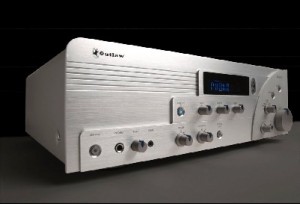 In terms of similar items available on Ebay today (June 4/12) the total is $643 (freight not included). You could subtract the $25 for a separate cd player if you like, so $618. I think this is about as low as one can go and get something quite satisfying sound-wise and to a high quality level. This system is suitable for 2.1 channel listening with AM/FM, compact disc, DVD movies, SACD and analog records. I invite all writers and readers to post their comments or their personal experiences regarding a system put together on a pauper’s salary, and look forward to what other Affordable$$Audio writers put together for their reference system at their choice of financial involvement.
In terms of similar items available on Ebay today (June 4/12) the total is $643 (freight not included). You could subtract the $25 for a separate cd player if you like, so $618. I think this is about as low as one can go and get something quite satisfying sound-wise and to a high quality level. This system is suitable for 2.1 channel listening with AM/FM, compact disc, DVD movies, SACD and analog records. I invite all writers and readers to post their comments or their personal experiences regarding a system put together on a pauper’s salary, and look forward to what other Affordable$$Audio writers put together for their reference system at their choice of financial involvement.
Obviously new systems will be much more expensive, and I might suggest that a system capable of this level of performance might cost someone in the neighbourhood of $2500-$3000. For a new “budget reference” system I might consider the following (at least what I think might perform on-par with my budget reference system):
- receiver/integrated amplifier (prefer with phono stage): Outlaw Audio receiver (includes MM phono stage) $700.
- cd/dvd player: Pioneer DV-300i (if it’s good enough for Goldmund to use as a base, good enough for me). It may need a litle work, but… , current model is the DV-429-K MSRP, $89 (unsure if fundamentally the same, but worth the risk).

- turntable: Rega RP1, $500 including cartridge.
- loudspeakers: planet10-hifi CHR70eN drivers + professionally made enclosures for the same including finishing, $200 + $320 (flatpack) + $150 DIY finishing, Kl: minimum $670, however Dave Dlugos of planet10-hifi has suggested different drivers and different enclosures, so I’ll push it to $900
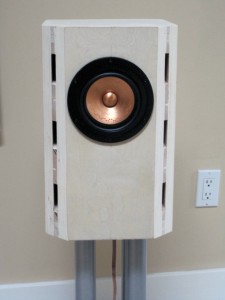
- subwoofer (optional): I’ve decided against one, completely as I usually never listen to one, but if needed budget at least $400 for a decent 10” or 12” (maybe NHTti) or a great DIY one based on a good plate amp with a stereo cross-over and low level output.
- interconnects/speaker cables: Moray James throughout, I’m allowing $400, but good cables from any reputable cable company are required. At least one pair, and say a 10′ pair of speaker cables.
- 5 Shelf Ikea “Lack-rack”, $75 + $10 for minor supplies/hardware
The total using these components and pricing is about $3085 without any shipping or tax. I have never heard the Outlaw Audio RR2150 receiver, but it has always gotten good reviews (including one in Affordable$$Audio, Jan 2006 ) and seems like a reasonable piece with suffcient quality and the ability to drive many loudspeaker types. Also rather than use the included cartridge with the RP1, you could consider something else (say a Grado, my fave) for around $100. And if the amplifier that you chose doesn’t come with a phono stage, you can do a lot worse than the Hagertech Bugle ($189 built). The thing is, there are so many iterations possible, where do you endti I know there are other favourites out there, and I can list a few alternatives as well. If I wanted an outstanding (rather than merely excellent) integrated, I’d suggest the Exposure 2010S and the optional phono stage card ($1495 + $219) which has been around for a little while in one form or another. I am a sucker for integrated amps…
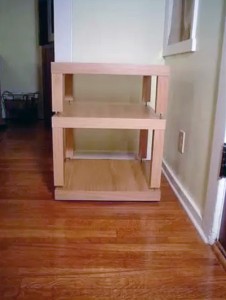
Next time I should have my “budget reference” system together in the Lack Rack (or whatever other rack I can get my hands on) and set up for listening. After that I plan on doing the DIY “thing” and see what improvements can be made for very little additional money. Until then, have some comfort knowing even if you don’t have “big money” you can still have a BIG smile on your face as you enjoy your very own “budget reference” system. I know I will.
By Stew Nelless, affordableaudio
